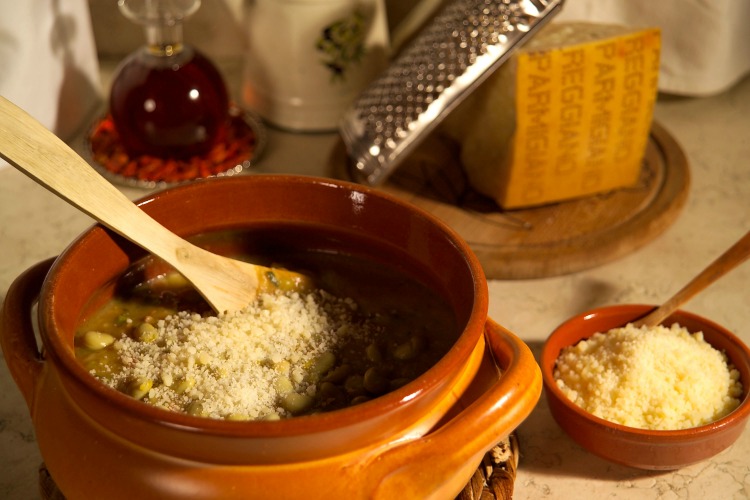Not all Parmigiano Reggiano cheese was created equal.

In fact, genuine, authentic Parmigiano-Reggiano is only, and can only, be produced in one area of the world, located in the Emilia-Romagna region: an area of hills and valleys, framed by two rivers, the Po and the Reno, encompassing the provinces of Parma, Reggio Emilia, Modena, and part of Bologna and Mantova.
The connection between the cheese and the land where it is produced is strong: Parmigiano-Reggiano is made today as it was made nine centuries ago, when Benedictine monks began production of the cheese in this area; the maestri casari, the modern-day cheese-makers, continue to use the same ingredients, repeat the same gestures and work with the same passion to craft a product that is a symbol and pride of the Made in Italy in the food sector.
The ingredients used to make Parmigiano-Reggiano are simple: milk, salt -used to enhance flavor and as a natural preservative- and rennet. The milk, the air and the water all contribute to give Parmigiano-Reggiano its unique and intense flavor; but most of all is the slow, careful aging – 24 months on average – and the skillful gestures of the maestri casari that give the cheese its different nuances and distinctive texture.
Try for yourself! For a list of caseifici (dairy farms) that sell Parmigiano-Reggiano directly to the public or online, click here.
The Craftsmanship of Parmigiano-Reggiano
The process of making Parmigiano Reggiano begins overnight, when the evening milking is brought to the cheese house and left resting in metal trays. During the night, the fat part of the milk -the cream- rises. The next morning, the cream is removed and the remaining skimmed milk is combined with whole milk from the morning milking.
- The combined milk from the evening and morning milking is warmed in large cauldrons.
- Naturally-fermented whey from the previous day’s production is stirred in. This highly-nutritious ingredient starts the acidification of the milk.
- The cheese maker then adds calf’s rennet, which coagulates the milk. After about 20 minutes, curds form.
- Using a balloon whisk called spino, the cheesemaker skillfully whisks the curds-and-whey mixture until the curds have been broken into tiny pieces the size of a wheat grain.
- The cheese maker cooks the mixture at a specific temperature (131˚ Fahrenheit). When the heat is turned off, the curds sink to the bottom of the cauldron where they knit together.
- Using a wooden paddle, the cheese maker lifts the spongy mass from the bottom and divides it in half. He wraps each half in muslin and hangs them on poles.
- Each half is wrapped in muslin and hung on poles to shed excess liquid.
- The cheeses are transferred to round wooden forms to give them their characteristic shape.
- The newly-formed “wheels” (forme in Italian) soak in sea-salt solution for 20-25 days.
- After soaking, the wheels are taken into the aging room, where they remain for a year. Every 10 days, each wheel is carefully wiped, brushed and turned.
- After 12 months, certified master cheese-testers determine if the wheels comply with the strict standards of the Consorzio del Parmigiano Reggiano, the organization that certifies authentic Parmigiano Reggiano.
- The “forme” that pass the test are fire-branded with the famous oval certification mark (DOP). Most wheels continue to age for another 12 months, as 24 months is the ideal aging time for Parmigiano Reggiano.
Would you like to see the cheese makers in action? Schedule a visit through Consorzio Parmigiano Reggiano.
How to savor Parmigiano-Reggiano

Parmigiano-Reggiano isn’t just grated on pasta! It is actually very versatile in the kitchen.
Use Parmigiano-Reggiano:
- AS AN APPETIZER: the best Parmigiano to be used as an appetizer has aged for 18 months. It is ideal with raw vegetables, celery and sweet little tomatoes. To enhance its delicate flavor, try it with fruit mustard, such as kiwi, apricot and melon. To be served with a glass of dry white wine.
- TO ADD FLAVOR TO PASTA AND SOUPS: use Parmigiano aged at 24 months. It is perfect with pasta, risotto, soups, either grated or in flakes.
- WITH MEAT AND SEAFOOD: 22 to 30 months aging time is the perfect Parmigiano for carpacci of meat and seafood, cut in thin flakes, with arugula and just a drop of olive oil. This aging time goes well with more robust red wines.
- WITH VEGETABLES AND SALADS: Parmigiano-Reggiano is perfect with fresh salads and seasonal vegetables; it is an essential ingredient for making quiches, baked vegetables and some traditional recipes, like eggplant parmigiana.
- WITH FRESH FRUIT AND NUTS: 15- to 18-month-old Parmigiano is fantastic with fresh fruit such as pears, apples, grapes and strawberries. 24- to 28-month-old Parmigiano is perfect with dry fruit, such as figs and plums, as well as walnuts and hazelnuts.
- WITH BALSAMIC VINEGAR: Finally, cut a thick flake of 30 to 36-month-old Parmigiano and taste it with a drop of traditional balsamic vinegar.
Photos courtesy of Consorzio Parmigiano Reggiano



24 thoughts on “Parmigiano Reggiano: The King of Cheeses”